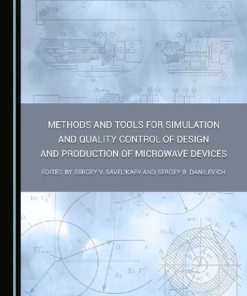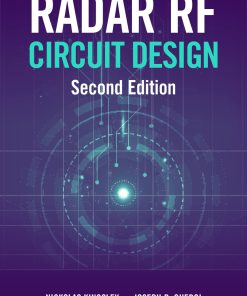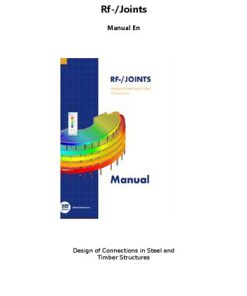The load pull method of RF and microwave power amplifier design 1st Edition by John Sevic ISBN 9781118898178 1118898176
$50.00 Original price was: $50.00.$25.00Current price is: $25.00.
The load pull method of RF and microwave power amplifier design 1st Edition by John Sevic – Ebook PDF Instant Download/Delivery: 9781118898178 ,1118898176
Full download The load pull method of RF and microwave power amplifier design 1st Edition after payment
Product details:
ISBN 10: 1118898176
ISBN 13: 9781118898178
Author: John Sevic
The load pull method of RF and microwave power amplifier design 1st Edition Table of contents:
Chapter 1 Historical Methods of RF Power Amplifier Design
1.1 The RF Power Amplifier
1.2 History of RF Power Amplifier Design Methods
1.2.1 Copper Tape and the X‐Acto Knife
1.2.2 The Shunt Stub Tuner
1.2.3 The Cripps Method
1.3 The Load‐Pull Method of RF Power Amplifier Design
1.3.1 History of the Load‐Pull Method
1.3.2 RF Power Amplifier Design with the Load‐Pull Method
1.4 Historical Limitations of the Load‐Pull Method
1.4.1 Minimum Impedance Range
1.4.2 Independent Harmonic Tuning
1.4.3 Peak and RMS Power Capability
1.4.4 Operating and Modulation Bandwidth
1.4.5 Linearity Impairment
1.4.6 Rigorous Error Analysis
1.4.7 Acoustically Induced Vibrations
1.5 Closing Remarks
References
Chapter 2 Automated Impedance Synthesis
2.1 Methods of Automated Impedance Synthesis
2.1.1 Passive Electromechanical Impedance Synthesis
2.1.2 The Active‐Loop Method of Impedance Synthesis
2.1.3 The Active‐Injection Method of Impedance Synthesis
2.2 Understanding Electromechanical Tuner Performance
2.2.1 Impedance Synthesis Range
2.2.2 Operating Bandwidth
2.2.3 Modulation Bandwidth
2.2.4 Tuner Insertion Loss
2.2.5 Power Capability
2.2.6 Vector Repeatability
2.2.7 Impedance State Resolution and Uniformity
2.2.8 Factors Influencing Tuner Speed
2.2.9 The Slab‐Line to Coaxial Transition
2.3 Advanced Considerations in Impedance Synthesis
2.3.1 Independent Harmonic Impedance Synthesis
2.3.2 Sub‐1 O Impedance Synthesis
2.4 Closing Remarks
References
Chapter 3 Load‐Pull System Architecture and Verification
3.1 Load‐Pull System Architecture
3.1.1 Load‐Pull System Block Diagram
3.1.2 Source and Load Blocks
3.1.3 Signal Synthesis and Analysis
3.1.4 Large‐Signal Input Impedance Measurement
3.1.5 AM–AM, AM–PM, and IM Phase Measurement
3.1.6 Dynamic Range Optimization
3.2 The DC Power Source
3.2.1 Charge Storage, Memory, and Video Bandwidth
3.2.2 Load‐Pull of True PAE
3.2.3 The Effect of DC Bias Network Loss
3.3 The DGT Method of System Verification
3.4 Electromechanical Tuner Calibration
3.5 Closing Remarks
References
Chapter 4 Load‐Pull Data Acquisition and Contour Generation
4.1 Constant Source Power Load‐Pull
4.1.1 Load‐Pull with a Single Set of Contours
4.1.2 Load‐Pull with Two or More Sets of Contours
4.1.3 Load‐Pull for Signal Quality Optimization
4.1.4 Large‐Signal Input Impedance
4.2 Fixed‐Parametric Load‐Pull
4.2.1 Fixed Load Power
4.2.2 Fixed Gain Compression
4.2.3 Fixed Peak–Average Ratio
4.2.4 Fixed Signal Quality
4.2.5 Treating Multiple Contour Intersections
4.3 Harmonic Load‐Pull
4.3.1 Second Harmonic Load‐Pull
4.3.2 Third‐Harmonic Load‐Pull
4.3.3 Higher‐Order Effects and Inter‐harmonic Coupling
4.3.4 Baseband Load‐Pull for Video Bandwidth Optimization
4.4 Swept Load‐Pull
4.4.1 Swept Available Source Power
4.4.2 Swept Bias
4.4.3 Swept Frequency
4.5 Advanced Techniques of Data Acquisition
4.5.1 Simplified Geometric‐Logical Search
4.5.2 Synthetic Geometric‐Logical Search
4.5.3 Multidimensional Load‐Pull and Data Slicing
4.5.4 Min–Max Peak Searching
4.6 Closing Remarks
References
Chapter 5 Optimum Impedance Identification
5.1 Physical Interpretation of the Optimum Impedance
5.2 The Optimum Impedance Trajectory
5.2.1 Optimality Condition
5.2.2 Uniqueness Condition
5.2.3 Terminating Impedance
5.3 Graphical Extraction of the Optimum Impedance
5.3.1 Optimum Impedance State Extraction
5.3.2 Optimum Impedance Trajectory Extraction
5.3.3 Treatment of Orthogonal Contours
5.4 Optimum Impedance Extraction from Load‐Pull Contours
5.4.1 Simultaneous Average Load Power and PAE
5.4.2 Simultaneous Average Load Power, PAE, and Signal Quality
5.4.3 Optimum Impedance Extraction Under Fixed‐Parametric Load‐Pull
5.4.4 PAE and Signal Quality Extraction Under Constant Average Load Power
5.4.5 Optimum Impedance Extraction with Bandwidth as a Constraint
5.4.6 Extension to Source‐Pull
5.4.7 Extension to Harmonic and Base‐Band Load‐Pull
5.5 Closing Remarks
Chapter 6 Matching Network Design with Load‐Pull Data
6.1 Specification of Matching Network Performance
6.2 The Butterworth Impedance Matching Network
6.2.1 The Butterworth L‐Section Prototype
6.2.2 Analytical Solution of the Butterworth Matching Network
6.2.3 Graphical Solution of the Butterworth Matching Network
6.3 Physical Implementation of the Butterworth Matching Network
6.3.1 The Lumped‐Parameter Butterworth Matching Network
6.3.2 The Distributed‐Parameter Butterworth Matching Network
6.3.3 The Hybrid‐Parameter Butterworth Matching Network
6.4 Supplemental Matching Network Responses
6.4.1 The Chebyshev Response
6.4.2 The Hecken and Klopfenstein Responses
6.4.3 The Bessel–Thompson Response
6.5 Matching Network Loss
6.5.1 Definition of Matching Network Loss
6.5.2 The Effects of Matching Network Loss
6.5.3 Minimizing Matching Network Loss
6.6 Optimum Harmonic Termination Design
6.6.1 Optimally Engineered Waveforms
6.6.2 Physical Implementation of Optimum Harmonic Terminations
6.6.3 Optimum Harmonic Terminations in Practice
6.7 Closing Remarks
References
Index
People also search for The load pull method of RF and microwave power amplifier design 1st Edition:
rf load pull
load pull microwave
load pull theory
what is rf and microwave engineering
load-pull techniques with applications to power amplifier design
You may also like…
Religion & Spirituality - Christianity
Uncategorized
Uncategorized
Engineering - Engineering - General & Miscellaneous
Energy Management : Big Data in Power Load Forecasting 1st Edition Valentin A. Boicea
Engineering - Electrical & Electronic Engineering
Uncategorized












